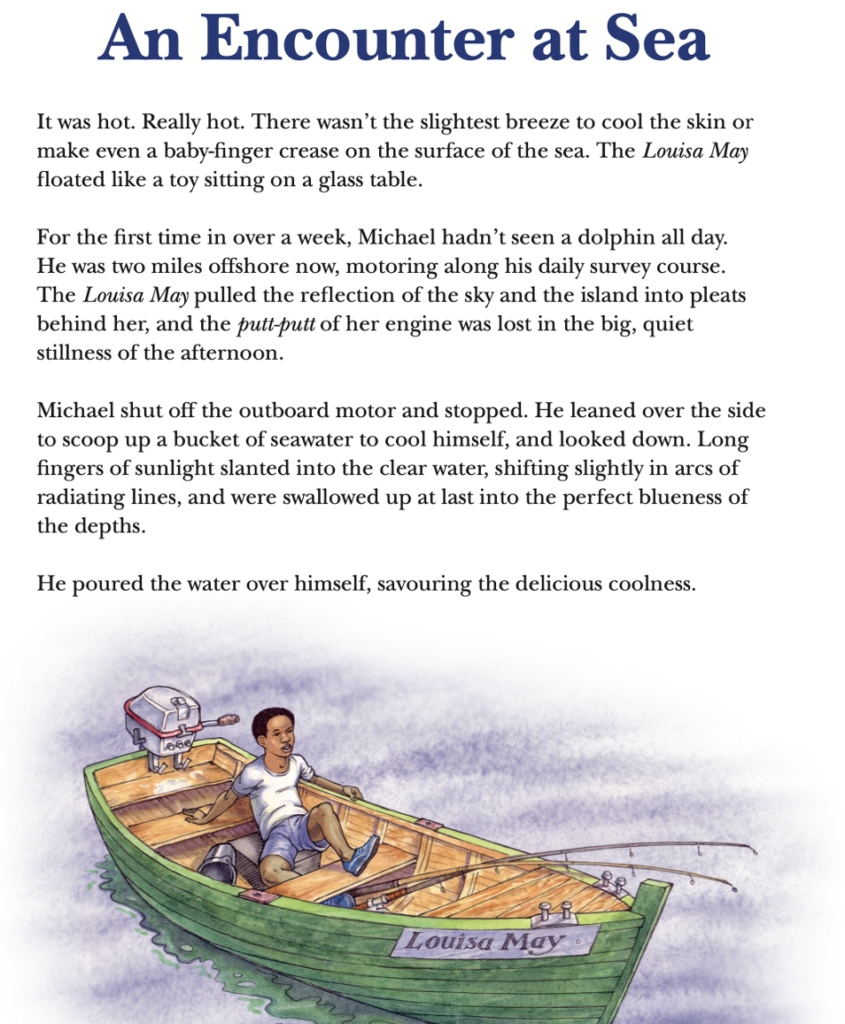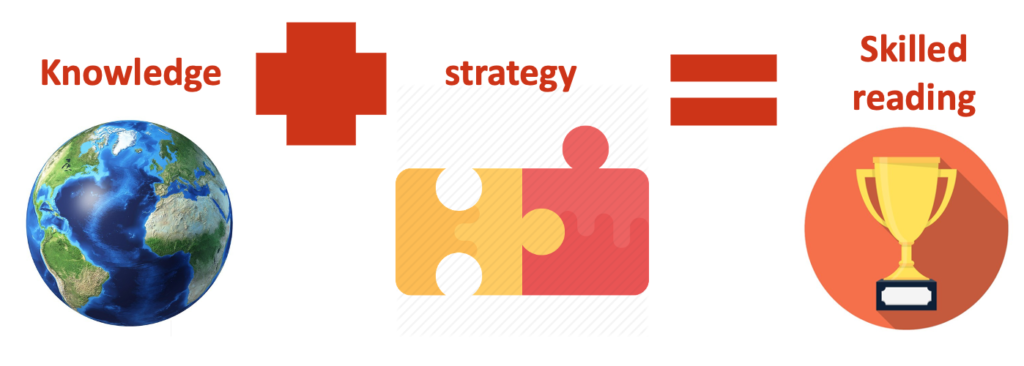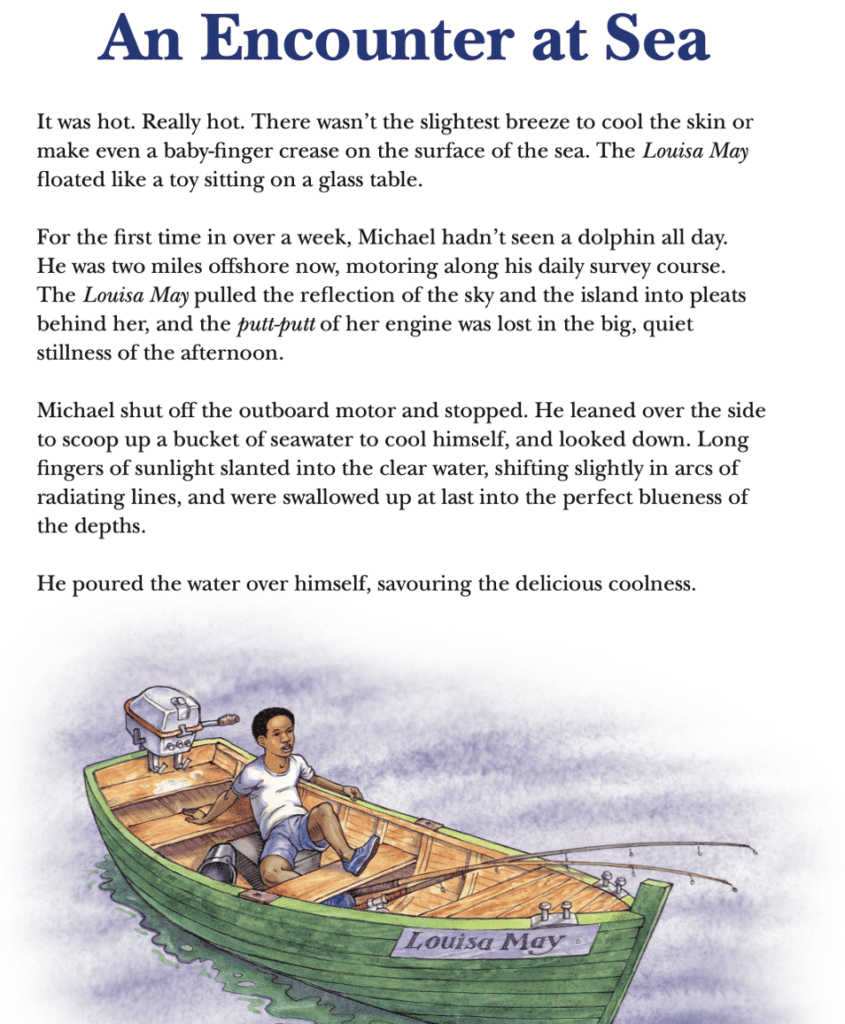Take a read of this passage, entitled ‘An Encounter at Sea’, from the 2017 reading comprehension SATs paper. Can you predict what happens next?

What did you predict? Did you assume the ‘encounter’ was a dolphin (noting their mention in paragraph 2), perhaps a shark attack (for the ‘Jaws’ aficionados), or even a whale (‘Moby Dick’, anyone?) for a more dramatic and dangerous encounter? Maybe the encounter was another boat, or an approaching storm?
Now, let’s concentrate on that reading comprehension strategy of ‘prediction’ that you deployed.
It makes sense to encourage prediction with narrative texts because we assume that most readers can draw upon a vast store of story structures and genre knowledge. Questions and discussion attending predictions helps pupils activate their background knowledge of similar stories, structures, and patterns of language… if they possess enough knowledge to generate their predictions.
Such knowledge of stories, and their structures, complex patterns of characters, themes, and language, is like the sea in the Michael’s encounter: it is deep, wide, and vast, and – though not wholly visible – it proves vital to the entire story. As such, the ability of pupils to make meaningful predictions, and to comprehend what they read, rests upon a sea of background knowledge.
As E. D. Hirsh pithily put it:
“To grasp the words on a page we have to know a lot of information that isn’t set down on a page.”
For 11-year-old pupils, sitting and reading their SATs paper under timed conditions, the task is very demanding. They must get to grips with multiple texts that require a vast store of background knowledge, vocabulary knowledge, understanding of genre, audience, imagery (“baby finger crease”, anyone?), and more. Additionally, they need to be strategic: quickly clarifying the meaning of words, predicting next steps in the story structure, or questioning whether their prior knowledge of stories and informational text topics applies to the text at hand.
Knowledgeable readers who deploy timely strategies succeed in SATs and go on to access the curriculum in secondary school.
The reading jigsaw
We can use the analogy of piecing together a jigsaw to describe the complex act of building comprehension every time we read, whether it is a story in year 6, or a textbook chapter in year 9 geography.
Let’s imagine that knowledge of vocabulary, genre, and understanding of structural features, along with identifying patterns of imagery, are the essential pieces of the jigsaw (read Professor Dan Willingham’s article on ‘How Knowledge Helps’ on why all the pieces matter). Reading comprehension strategies like ‘prediction’, ‘questioning’, ‘clarifying’, ‘summarising’ and ‘activating prior knowledge’ are the strategies to marshal the pieces of the jigsaw – just like starting with the corners – or clustering by colour when strategising your jigsaw (read Professor Tim Shanahan on ‘Comprehension skills or strategies: Is there a difference and does it matter’ to identify the value of reading comprehension strategies).
With the aforementioned story, getting you to predict what may happen next, or clarifying the reference to the dolphin, can go some way to activating and steering your background knowledge to piece together full comprehension. Broadly, such reading comprehension strategies help pupils to better organised their crucial background knowledge to construct the big picture of the text (known as a ‘schemata’ or a ‘mental model’ in various research interpretations).
We can take the jigsaw analogy and simplify the complex act of reading comprehension as follows:

Alas, like many simple models or analogies for complex acts, it isn’t quite so simple (!), but let’s go with the analogy.
The importance of building background knowledge
What happens when you lack vocabulary knowledge, or knowledge of similar story structures? Well, you miss fundamental pieces of the comprehension jigsaw. No comprehension strategy can help a pupil who does not have the knowledge to understand the words, structures, or patterns of a story or text.
Why do so many pupils lack the background knowledge to comprehend new, unfamiliar texts? For too many pupils, they lack deep reading experience of years of rich reading that develops knowledge of the predictable patterns of imagery, along with the rare and sophisticated vocabulary, that populates books and the perennial reading texts of the school classroom.
These pupils are continually missing vital pieces of the puzzle, so their comprehension is partial and compromised each time they read. They don’t remember what they read because they do not gain a coherent full picture of it, and this problem is compounded each time they read or return to topics in the school curriculum. Pupils who lack knowledge of the texts, genre, and words the read in the classroom don’t improve with a regular diet of reading comprehension strategies alone. We need to pay attention to connecting developing background knowledge and reading experiences into a coherent, sequenced curriculum.
So, if we know background knowledge is so crucial to reading success, then what is the problem? Well, it appears we don’t always support struggling readers to build this knowledge.
Instead of starting with a careful curation of background knowledge – such as reading related texts on topic, and doing lots and lots of reading, we may spend too much time aping national reading comprehension assessments, such as the SATs reading paper, or GCSE English language questions.
Paradoxically, pupils read less if they are doing too much practice of reading comprehension exam style assessments, with truncated reading extracts, and writing answers to legions of comprehension questions. If pupils only experience a diet of lots of short, disconnected texts, then they won’t be exposed to the complex demands of academic reading that build a rich, full picture of background knowledge and the pleasure that attends familiarity with a genre or topic.
Of course, pupils need some practice of national reading assessments, so they can understand the time pressures and gain some familiarity with question types. But, crucially, to succeed in those reading comprehension assessments, we need far fewer mocks and mini-faux exams dressed up as reading, to free up curriculum time to read whole texts. Whole texts that develop arguments, extend descriptions, slowly reveal characters. Whole texts that invariably don’t fit into easy bitesize worksheets with easy acronyms. IN short, reading that is compellingly challenging so that strategic thinking is necessary and worthwhile.
Is developing background knowledge enough?
So, if we just teach them all they need to know in an organised reading sequence, will that do the trick… background knowledge is everything, right? Well, not quite!
We cannot simply teach all the background knowledge at the exact right time and in the exact right order (though sequencing knowledge is a meaningful task for teachers). Research studies have revealed the struggle to translate the teaching of background knowledge to direct gains of general reading comprehension. A reality is that pupils, especially in school, will need to strategically tackle texts that introduce new topics, ideas, and words. As such, a clear focus on knowledge building can be aligned with some timely strategy instruction (often rich classroom talk about the text at hand).
Let’s return to the formula:
Background knowledge + reading comprehension strategies = skilled reading
For decades there have been ample evidence for the efficacy of reading comprehension strategies. Strategies like ‘prediction’, ‘clarifying’ and ‘summarising’ are familiar in almost all classrooms to help pupils delve beneath the surface of unfamiliar topics and texts. They become valuable when pupils are piecing together the background knowledge they do possess with the new ideas, words, imagery, and ideas that they are being exposed to as they read the new text in the classroom.
What may have been lost over the decades is the apt weighing of the skilled reading formula. The EEF Teaching & Learning Toolkit entry on ‘Reading Comprehension Strategies’ reveals behind the average that:

Strategy instruction is likely brief – and is revisited briefly too. As such, there is little justification for practising endless ‘prediction’ questions each week of the school year in the hope pupils become better readers, if we pay too little attention to the ‘what’ of the prediction.
We can conceive curriculum development as cohering around the ‘what’ of the books being read and the topics being selected and connected. You can start with the reading selection and then strategy instruction emerging out of the specifics of those texts.
If we want 11 year olds to read and comprehend ‘An Encounter at Sea’, then practising reading short extracts is unlikely to offer the benefits of reading more extended fiction. Instead, reading the actual novel which the encounter is from, ‘Whale Boy’, by Nicola Davies
[SPOILER: beneath the surface in ‘An Encounter at Sea’ lurks a whale!]
Perhaps this fiction could be reinforced by reading science texts about evolution and inheritance or the oceans of the world, and/or learning about Jonah, Moby Dick, and more. When reading related texts – fiction or informational texts – it helps pupils make connections, meaningfully repeated, and deepens understanding of ideas and vocabulary and popular powerful cultural imagery. Predictions become meaningful and more likely to be made by pupils.
Let’s simplify some of these insights for better developing skilled readers in the classroom:
- Start with careful planning a broad and balanced curriculum that brings a world of knowledge alive.
- Ensure pupils do lots and lots of reading of challenging texts.
- Support pupils to develop, connect and cohere their knowledge.
- Give pupils targeted, text sensitive support to deploy reading comprehension strategies, with a gradual release of responsibility.
- Avoid over-practising comprehension assessments that can compromise curriculum time for read extended texts.
